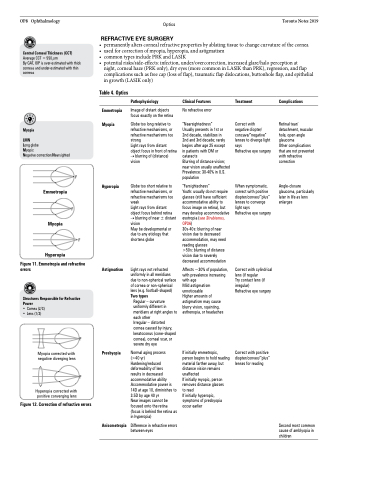Page 898 - TNFlipTest
P. 898
OP8 Ophthalmology
Optics Toronto Notes 2019
REFRACTIVE EYE SURGERY
• permanentlyalterscornealrefractivepropertiesbyablatingtissuetochangecurvatureofthecornea • usedforcorrectionofmyopia,hyperopia,andastigmatism
• commontypesincludePRKandLASIK
• potential risks/side-effects: infection, under/overcorrection, increased glare/halo perception at
night, corneal haze (PRK only), dry eyes (more common in LASIK than PRK), regression, and flap complications such as free cap (loss of flap), traumatic flap dislocations, buttonhole flap, and epithelial in growth (LASIK only)
Central Corneal Thickness (CCT)
Average CCT = 550 μm
By GAT, IOP is over-estimated with thick corneas and under-estimated with thin corneas
Myopia
LMN
Long globe
Myopic
Negative correction/Nearsighted
Emmetropia
Myopia
Hyperopia
F
F
Table 4. Optics
Emmetropia Myopia
Hyperopia
Pathophysiology
Image of distant objects focus exactly on the retina
Globe too long relative to refractive mechanisms, or refractive mechanisms too strong
Light rays from distant object focus in front of retina → blurring of (distance) vision
Globe too short relative to refractive mechanisms, or refractive mechanisms too weak
Light rays from distant object focus behind retina → blurring of near ± distant vision
May be developmental or due to any etiology that shortens globe
Light rays not refracted uniformly in all meridians due to non-spherical surface of cornea or non-spherical lens (e.g. football-shaped) Two types
Regular – curvature uniformly different in meridians at right angles to each other
Irregular – distorted cornea caused by injury, keratoconus (cone-shaped cornea), corneal scar, or severe dry eye
Normal aging process
(>40 yr)
Hardening/reduced deformability of lens
results in decreased accommodative ability Accommodative power is 14D at age 10, diminishes to 3.5D by age 40 yr
Near images cannot be focused onto the retina (focus is behind the retina as in hyperopia)
Difference in refractive errors between eyes
Clinical Features
No refractive error
“Nearsightedness”
Usually presents in 1st or 2nd decade, stabilizes in
2nd and 3rd decade; rarely begins after age 25 except
in patients with DM or cataracts
Blurring of distance vision; near vision usually unaffected Prevalence: 30-40% in U.S. population
“Farsightedness”
Youth: usually do not require glasses (still have sufficient accommodative ability to focus image on retina), but may develop accommodative esotropia (see Strabismus, OP36)
30s-40s: blurring of near vision due to decreased accommodation, may need reading glasses
>50s: blurring of distance vision due to severely decreased accommodation
Affects ~30% of population, with prevalence increasing with age
Mild astigmatism unnoticeable
Higher amounts of astigmatism may cause blurry vision, squinting, asthenopia, or headaches
If initially emmetropic, person begins to hold reading material farther away, but distance vision remains unaffected
If initially myopic, person removes distance glasses
to read
If initially hyperopic, symptoms of presbyopia occur earlier
Treatment
Correct with
negative diopter/ concave/”negative” lenses to diverge light rays
Refractive eye surgery
When symptomatic, correct with positive diopter/convex/”plus” lenses to converge light rays
Refractive eye surgery
Correct with cylindrical lens (if regular
Try contact lens (if irregular)
Refractive eye surgery
Correct with positive diopter/convex/”plus” lenses for reading
Complications
Retinal tear/ detachment, macular hole, open angle glaucoma
Other complications that are not prevented with refractive correction
Angle-closure glaucoma, particularly later in life as lens enlarges
Figure 11. Emmetropia and refractive errors
Structures Responsible for Refractive Power
• Cornea (2/3)
• Lens (1/3)
Astigmatism
Myopia corrected with negative diverging lens
Hyperopia corrected with positive converging lens
F
F
F
Figure 12. Correction of refractive errors
Presbyopia
Anisometropia
Second most common cause of amblyopia in children


